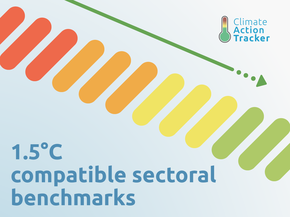Country summary
Overview
Last year, Chile showed its commitment and leadership for climate action after volunteering to host the upcoming UNFCCC COP25. However, as the government struggles with political and social challenges, the COP in Santiago was moved to Madrid. Chile continues to hold the presidency of COP25 and has taken a first step towards scaling up climate ambition by releasing a draft Paris Agreement NDC update, with new and more ambitious targets for 2030. This was released for public consultation in October 2019.
The current Chilean 2030 NDC target is presently rated as “Highly insufficient”. However, if the country were to officially update its NDC based on the unconditional target for 2030 proposed in its October 2019 draft Paris Agreement NDC update we would upgrade its rating to “Insufficient.” In addition, the conditional 2030 target in the draft Paris Agreement NDC update is much more ambitious, and whilst the numbers are still unclear, it could even be 1.5˚C Compatible.
In addition to the proposed 2030 targets, key structural elements of Chile’s proposed Nationally Determined Contribution (NDC) are also more ambitious: economy-wide emissions reductions, a carbon budget, and targets for the forestry sector. It includes a conditional NDC target, the 2030 targets are linked to the 2050 carbon neutrality goal, and it embeds all in the planning process.
If Chile were to implement all of its planned policies, it could peak its emissions in 2023 - even earlier than the proposed peak in 2027. This would be a remarkable achievement and set the country up as a front-runner on climate action.
More details of Chile’s draft Paris Agreement update here.
For the full analysis click the button below.
Chile is currently formulating a new Climate Change Framework Law whose main objectives are a transition to a low emissions development towards achieving GHG neutrality in 2050, increasing resilience against climate change effects, and complying with international climate change commitments. The current draft bill that was open for public input includes governance, management instruments, financing measures and economic instruments.
If approved, this bill would enshrine Chile’s 2050 GHG emissions neutrality target into legislation.
These developments are all positive but as with many countries, coal remains a significant issue and clouds the outlook. After announcing, in early 2018, the aim to phase-out unabated coal-fired electricity generation by 2040, Chile announced in June 2019 its aim to be carbon-neutral by 2050. Its detailed coal-fired power plant shut-down would be equivalent to 20% of its coal electricity capacity by 2024. However, around the same time of this announcement, a new 375 MW coal-fired power plant in Mejillones (equivalent to about 1.8 TWh per year) started operations and two of its eight oldest ones (equivalent to 170 MW or 0.6 TWh per year) were closed. In other words, Chile has been giving mixed signals on climate action - on the one hand it announced a detailed first stage for shutting down the first eight coal-fired power plants— starting quickly with the first two — while on the other it opened a brand new coal-fired plant that will produce three times more electricity than the combination of the two it closed.
While these two actions give mixed signals about Chile’s climate commitments, it remains to be seen what the full decarbonisation plan between 2024 and 2040 will look like. Although a full coal phase-out would be a substantial step for a country with a 40% coal electricity supply, the CAT believes Chile could achieve this phase-out significantly sooner than 2040. Phasing out all coal-fired power plants at the latest by 2032 is an action compatible with the global sectoral benchmark for electricity sector under a scenario in line with the Paris Agreement for the Latin America region, this is eight years ahead of Chile’s coal phase-out plan.


According to our assessment, Chile will meet its current Nationally Determined Contribution (NDC) unconditional target with currently implemented policies, under which emissions would reach levels (excluding LULUCF) of 122-126 MtCO2e by 2030 (8-12% above 2016 levels). Under a full implementation of all its planned policies, including the shutdown of all coal power plants and the electromobility strategy, Chile could overachieve its current conditional NDC target, and reach emissions levels (excluding LULUCF) of 99-101 MtCO2e by 2030 (11-13% below 2016 levels).
Our current policy emissions pathway includes the Unconventional Renewable Energy Law (Law 20.257/2008), the carbon tax (Law 20.780/2014), the results of electricity supply tenders as of December 2017, emissions reductions from the retirement of the first eight coal-fired power plants announced in 2019, and the Electromobility Strategy, which sets out an action plan to achieve electrification of a 40% share of the private vehicle fleet—and 100% of public urban transport—by 2050.
Our analysis suggests that Chile will overachieve its 2020 pledge and its unconditional NDC target with currently implemented policies. If Chile were to replace electricity generation from the eight coal-fired power plants scheduled to retire by 2024 with renewable energy, it would additionally reach the upper end of its conditional NDC target (as assumed in the lower end of current policy projections).
Additionally, the Energy Route 2018–2022 establishes commitments for further emissions reductions. These commitments include quadrupling small distributed renewable energy capacity by 2022, establishing a legal framework for energy efficiency in the industry, mining, transport, and buildings sector, implementing a ten-fold increase of current EVs share and regulating solid biofuels (i.e. wood). We have not included these targets in our current policy projection and will only do so as concrete policies to achieve these targets are implemented.
Besides setting goals and developing plans, Chile has also started to take action. In 2018, Chile began moving away from coal, increased its renewable energy generation share to 21%, reformed its “Net Billing” Law, significantly increased its electric taxis and urban electric bus shares, and introduced a new Energy Efficiency Law – which has been approved by the Congress but will only be implemented after the approval of the Comptroller General of Chile and its publication in the Official Journal. These policy changes have not been included in our current policy pathway nor planned policies scenario due to lack of available data.
Additionally, we have estimated the impact of a complete coal phase-out by 2040 under a planned policies scenario. Under this scenario Chile would get closer to our 2°C compatible range. The main difference between the current policy and the planned policy scenarios lies in the assumptions of the long-term share of renewable energy and the retirement of coal fired power plants.
In the current policy scenario, the renewable electricity share increases towards 2020 to reach around 59% and then stalls and Chile retires the first eight power plants by 2024. The planned policy scenario considers a growing renewable energy generation share towards 2050, where it reaches 70% and assumes a linear retire of all coal power plants by 2040. Under the planned policy scenario, Chile achieve the renewable energy goals from its 2050 Energy Strategy.
We have also estimated a range for Chile’s net-zero carbon target for 2050. While this is highly dependent on the size of the forestry sinks, we estimate the lower end of the range would be consistent with the CAT rating category of 1.5°C Paris Agreement compatible for Chile.
Further analysis
Latest publications
Stay informed
Subscribe to our newsletter





